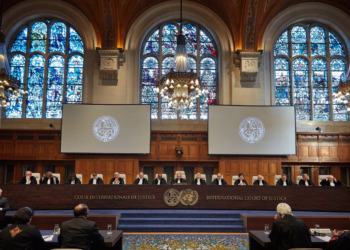Around the world, communities of color and marginalized groups disproportionately feel the effects of pollution and other environmental impacts. Whether it’s residents living along the polluted Cooum River in Chennai, India; Louisiana’s petrochemical-dense Cancer Alley; Thailand’s toxic hot spot Map Ta Phut Industrial Estate; or children living near a battery recycling factory in Naucalpan De Juárez, Mexico, environmental racism has long exposed poor people and people of color to dangerously high levels of lead, contaminated water and bad air. These communities suffer from high incidences of related ailments, such as cancer and asthma. Many have also witnessed the desecration of cultural landmarks.
A Natural Resources Defense Council report issued last year, Watered Down Justice, found that race is the factor that bears the strongest relationship to slow and ineffective enforcement of the federal drinking water law in communities across the United States. In Ecuador, the water pollution in Esmeraldas province, linked to palm oil plantations and mining, has caused skin rashes, genital infections and other serious illnesses. More than 90% of the Afro-Ecuadorian population living in Esmeraldas lack access to basic health care, protection or education, while 70% live below the poverty line. Government failure to enforce environmental controls has led to contamination of the water supplies, which local communities continue to use for drinking, bathing and washing their clothes, leading a UN Special Rapporteur to highlight the situation as an example of environmental racism. A 2015 report by the Inter American Commission on Human Rights also found pervasive problems associated with mining projects in territories where Indigenous Peoples and people of African descent live in the Americas, including contamination of soil and water and other negative health effects.
And yet, pollution and other environmental problems aren’t always viewed as examples of racial inequity. Groups around the world tend to treat environmental injustice and racial injustice as separate issues, when the reality is that environmental injustices often spring from systemic racism.
Groups may ignore the pattern of indigenous communities and other minority groups marginalized by race, poverty, caste and religion living on the frontline of the pollution crisis. The reality is that because of this marginalization, mitigating the impacts of pollution is often not a priority for government action. Connecting the two concepts can help advocates strengthen their environmental injustice work by fighting the root causes of discrimination and ensuring that marginalized communities have a voice in decision making.
Environmental groups in the United States offer inspiring lessons for communities around the world on how fighting environmental injustices through the lens of racial inequity can curb pollution while improving equity.
Examples From the United States
The term “environmental racism” was coined in the United States in 1982 by African American civil rights leader Benjamin Chavis. A landmark 2007 study by academic Dr. Robert Bullard, the “father of environmental justice,” found “race to be more important than socioeconomic status in predicting the location of the nation’s commercial hazardous waste facilities.” Bullard helped elevate the issue in the United States as an important target for advocacy.
Since then, community groups have successfully fought environmental problems by highlighting the underlying connection to systemic racism. For decades, environmental justice organizations across the United States have led the way, working alongside disenfranchised communities to combat environmental racism — both safeguarding low-income neighborhoods and people of color from toxic pollution, as well as dismantling the policies, laws and institutions that disproportionately expose these communities to greater environmental health risks. Even the current Black Lives Matter movement, while largely focused on ending police brutality, includes environmental justice in its list of legislative demands.
Related Articles: Environmentalists Should Pay Attention to the Racial Justice Movement | Environmental Racism
Here are a few examples, and the lessons they offer:
- WE ACT for Environmental Justice: New York City’s first environmental justice organization, WE ACT for Environmental Justice, successfully led efforts to mandate statewide lead testing of schools’ drinking water, citing evidence that this type of pollution was more prevalent in communities of color. The group also forced upgrades at a noxious sewage treatment plant that brought respiratory illness to poor neighborhoods in West Harlem and cleaned up air pollution from diesel buses that mostly affect these communities. The priority for all their work is ensuring people of color and/or low-income residents participate meaningfully in the creation of sound and fair environmental health and protection policies and practices. Their approach offers lessons on the importance of working with local universities on community-based participatory research and advancing grassroots campaigns with communities of color to improve environmental policy on environmental health and justice.WE ACT’s efforts expanded awareness on the disproportionate impacts of pollution on communities of color and strengthened city, state and federal policies on environmental health and justice for all people. This includes the country’s first Safe School Water Act, passed in 2016, which mandates testing and remediation for lead in all New York State schools. The organization also helped pass New York City’s Environmental Justice Study Bill and Environmental Justice Policy Bill, which provide New Yorkers more information to identify and address environmental injustices.
- Louisiana Bucket Bridge: The Louisiana Bucket Brigade has been leading the fight to end the negative effects of the petroleum industry on communities in Louisiana, with a focus on the expansion of the industry and its impact on historically African American communities. The group advocates for moving away from fossil fuels, collaborating with communities and amplifying their voices to help them achieve protection of their health and homes. The organization does this by working directly with “fence-line communities,” a term used to describe people living right next to polluting facilities, on the discriminatory impacts oil and chemical pollution is causing to their homes, health and lives. They are also building tools that communities can use for pollution monitoring, such as mapping resident-reported pollution incidents; using low-cost air pollution sensors approved by the Environmental Protection Agency to document pollution; and collecting pollution monitoring data needed to support advocacy to address enforcement gaps. The Bucket Brigade has revolutionized the idea of communities monitoring toxic air emissions. They have promoted these monitoring techniques throughout refinery belts across the United States and influenced other organizations around the globe.
- Utah Diné Bikéyah: Diné Bikéyah (pronounced di-NAY bi-KAY-uh) means “people’s sacred lands” in the Navajo language. They are working with the five sovereign Tribes of the Bears Ears Inter-Tribal Coalition to protect the Bears Ears National Monument, an ancestral site, from mining and future development. This site has held cultural significance for generations of Diné, Hopi, Zuni, Pueblo and Ute peoples. Their strategy includes raising awareness and identifying solutions that address the stark discrimination over access to water for Diné (Navajo) people, and ensuring Native people’s voter rights are protected and that they have appropriate representation in local government leadership. This strengthened voice in development decision-making helps overcome historical barriers to participation.
Taking it Global
The United States has hardly solved issues of systemic and environmental racism. Indeed, for every positive example of progress, there are countless more of continued injustices. But environmental justice groups have waged some hard-won battles — ones that could inspire communities around the world to tackle environmental issues as the racial injustices they often are.
These successes offer critical lessons to organizations working with minority groups around the world, including to start with the principle of Indigenous Peoples’ and communities’ self-determination; understand that fighting pollution often requires fighting long-term injustices that have had intergenerational impacts; and seeing pollution as preventable, but part of a struggle to address inequality and social injustice.
Learning from these approaches of environmental justice organizations across the United States, WRI’s Strengthening the Right to Information for People and the Environment (STRIPE) project supports locally led, community-determined fights against pollution around the world. Working with local civil society organizations in Asia, Latin America and Africa, STRIPE builds poor and marginalized communities’ capacity to leverage their rights to information and participation — internationally recognized human and environmental rights — to campaign for a clean, healthy and safe environment. This rights-based approach, pioneered by many environmental justice organizations, amplifies voices too often ignored, enabling local people to develop, advocate for and implement solutions that directly address their concerns. It also helps these same communities hold powerful government officials and polluters accountable. Developed in partnership with STRIPE’s partners, WRI’s Community-Led Action Toolkit, offers practical, tactical and strategic support to use these environmental rights as a vehicle for advocacy and justice.
It’s time to acknowledge that environmental injustice including cases of environmental racism are a political choice that pervades environmental decision-making and threatens to further entrench systemic inequalities. Moving forward, governments, political leaders and other multilateral institutions must recognize that the fight for sustainable development and poverty eradication is a fight for environmental justice. Environmental and social justice funders must also start prioritizing finance for environmental justice, including local and community-led fights. Legal and policy solutions can no longer ignore the unfair, racist price being asked of the world’s poor and minority communities.
— —
About the Authors: Elizabeth Moses is an Environmental Rights and Justice Associate II with the Environmental Democracy Practice (EDP). Carole Excell is the Director of World Resources Institute’s Environmental Democracy Practice and the Project Director for The Access Initiative.
Editor’s Note: The opinions expressed here by Impakter.com columnists are their own, not those of Impakter.com. — In the Featured Photo: Nangsao Witlawan, a resident of Thailand’s Map Ta Phut Industrial Estate, where pollution contaminates nearby wells with mercury and other toxins. Featured Photo Credit: Laura Villadiego.











